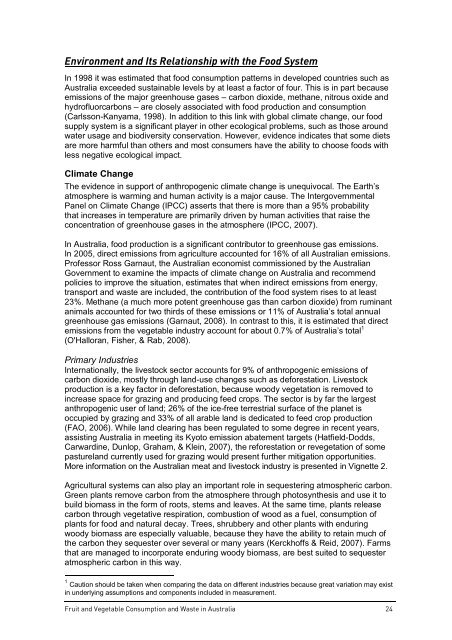Fruit and vegetable consumption and waste in Australia - VicHealth
Fruit and vegetable consumption and waste in Australia - VicHealth
Fruit and vegetable consumption and waste in Australia - VicHealth
Create successful ePaper yourself
Turn your PDF publications into a flip-book with our unique Google optimized e-Paper software.
Environment <strong>and</strong> Its Relationship with the Food System<br />
In 1998 it was estimated that food <strong>consumption</strong> patterns <strong>in</strong> developed countries such as<br />
<strong>Australia</strong> exceeded susta<strong>in</strong>able levels by at least a factor of four. This is <strong>in</strong> part because<br />
emissions of the major greenhouse gases – carbon dioxide, methane, nitrous oxide <strong>and</strong><br />
hydrofluorcarbons – are closely associated with food production <strong>and</strong> <strong>consumption</strong><br />
(Carlsson-Kanyama, 1998). In addition to this l<strong>in</strong>k with global climate change, our food<br />
supply system is a significant player <strong>in</strong> other ecological problems, such as those around<br />
water usage <strong>and</strong> biodiversity conservation. However, evidence <strong>in</strong>dicates that some diets<br />
are more harmful than others <strong>and</strong> most consumers have the ability to choose foods with<br />
less negative ecological impact.<br />
Climate Change<br />
The evidence <strong>in</strong> support of anthropogenic climate change is unequivocal. The Earth’s<br />
atmosphere is warm<strong>in</strong>g <strong>and</strong> human activity is a major cause. The Intergovernmental<br />
Panel on Climate Change (IPCC) asserts that there is more than a 95% probability<br />
that <strong>in</strong>creases <strong>in</strong> temperature are primarily driven by human activities that raise the<br />
concentration of greenhouse gases <strong>in</strong> the atmosphere (IPCC, 2007).<br />
In <strong>Australia</strong>, food production is a significant contributor to greenhouse gas emissions.<br />
In 2005, direct emissions from agriculture accounted for 16% of all <strong>Australia</strong>n emissions.<br />
Professor Ross Garnaut, the <strong>Australia</strong>n economist commissioned by the <strong>Australia</strong>n<br />
Government to exam<strong>in</strong>e the impacts of climate change on <strong>Australia</strong> <strong>and</strong> recommend<br />
policies to improve the situation, estimates that when <strong>in</strong>direct emissions from energy,<br />
transport <strong>and</strong> <strong>waste</strong> are <strong>in</strong>cluded, the contribution of the food system rises to at least<br />
23%. Methane (a much more potent greenhouse gas than carbon dioxide) from rum<strong>in</strong>ant<br />
animals accounted for two thirds of these emissions or 11% of <strong>Australia</strong>’s total annual<br />
greenhouse gas emissions (Garnaut, 2008). In contrast to this, it is estimated that direct<br />
emissions from the <strong>vegetable</strong> <strong>in</strong>dustry account for about 0.7% of <strong>Australia</strong>’s total 1<br />
(O'Halloran, Fisher, & Rab, 2008).<br />
Primary Industries<br />
Internationally, the livestock sector accounts for 9% of anthropogenic emissions of<br />
carbon dioxide, mostly through l<strong>and</strong>-use changes such as deforestation. Livestock<br />
production is a key factor <strong>in</strong> deforestation, because woody vegetation is removed to<br />
<strong>in</strong>crease space for graz<strong>in</strong>g <strong>and</strong> produc<strong>in</strong>g feed crops. The sector is by far the largest<br />
anthropogenic user of l<strong>and</strong>; 26% of the ice-free terrestrial surface of the planet is<br />
occupied by graz<strong>in</strong>g <strong>and</strong> 33% of all arable l<strong>and</strong> is dedicated to feed crop production<br />
(FAO, 2006). While l<strong>and</strong> clear<strong>in</strong>g has been regulated to some degree <strong>in</strong> recent years,<br />
assist<strong>in</strong>g <strong>Australia</strong> <strong>in</strong> meet<strong>in</strong>g its Kyoto emission abatement targets (Hatfield-Dodds,<br />
Carward<strong>in</strong>e, Dunlop, Graham, & Kle<strong>in</strong>, 2007), the reforestation or revegetation of some<br />
pasturel<strong>and</strong> currently used for graz<strong>in</strong>g would present further mitigation opportunities.<br />
More <strong>in</strong>formation on the <strong>Australia</strong>n meat <strong>and</strong> livestock <strong>in</strong>dustry is presented <strong>in</strong> Vignette 2.<br />
Agricultural systems can also play an important role <strong>in</strong> sequester<strong>in</strong>g atmospheric carbon.<br />
Green plants remove carbon from the atmosphere through photosynthesis <strong>and</strong> use it to<br />
build biomass <strong>in</strong> the form of roots, stems <strong>and</strong> leaves. At the same time, plants release<br />
carbon through vegetative respiration, combustion of wood as a fuel, <strong>consumption</strong> of<br />
plants for food <strong>and</strong> natural decay. Trees, shrubbery <strong>and</strong> other plants with endur<strong>in</strong>g<br />
woody biomass are especially valuable, because they have the ability to reta<strong>in</strong> much of<br />
the carbon they sequester over several or many years (Kerckhoffs & Reid, 2007). Farms<br />
that are managed to <strong>in</strong>corporate endur<strong>in</strong>g woody biomass, are best suited to sequester<br />
atmospheric carbon <strong>in</strong> this way.<br />
1 Caution should be taken when compar<strong>in</strong>g the data on different <strong>in</strong>dustries because great variation may exist<br />
<strong>in</strong> underly<strong>in</strong>g assumptions <strong>and</strong> components <strong>in</strong>cluded <strong>in</strong> measurement.<br />
<strong>Fruit</strong> <strong>and</strong> Vegetable Consumption <strong>and</strong> Waste <strong>in</strong> <strong>Australia</strong> 24


